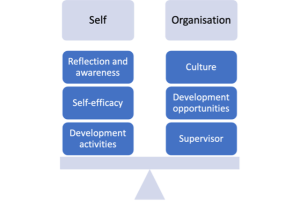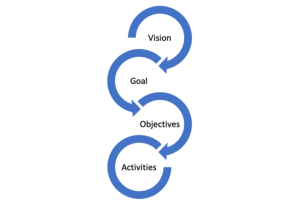6 Professional Development
At the end of the day, you are the only one that is limiting your ability to dream, or to actually execute on your dreams. Don’t let yourself get in the way of that
Falon Fatemi, Founders Node 10
 Learning Objectives
Learning Objectives
On completion of this chapter you should be able to:
- Understand the importance of professional development planning.
- Reflect on the relationship between the individual’s and the organisation’s responsibility for professional development.
- Develop a 5-year professional development plan using the interlinked cycle of career planning setting your vision, goal/s, objectives and activities.
Introduction
Organisations globally agree that one of the biggest challenges they face is building and sustaining a strong talent pipeline and that strategically aligned talent management is key to the success of organisations (Stahl et al. 2012). Talent management is a process that aims not only to recruit high calibre individuals, but to retain them through ongoing development, to improve individual effectiveness and therefore the success of the organisation. Effective talent management increases staff well-being and job satisfaction and decreases intention to leave the organisation (Barkhuizen et al., 2014). Organisations recognise that talent management is important, as in today’s knowledge-based economy the replacement of staff is costly and time-consuming (Horwitz et al., 2003). Most organisations then, invest in the ongoing professional development of their staff. Professional development can be defined as a lifelong process, for individuals in their professional context, to fulfill their potential.
 Watch our industry expert, Nicole Deacon, talk about why professional development is important.
Watch our industry expert, Nicole Deacon, talk about why professional development is important.
Of course, you may still be a student and are thinking this chapter is not for me – you’d be wrong! It is never too early to start thinking about your development needs. This chapter will talk about professional development generally but remember all of the information below can be adapted to whatever situation you find yourself in, just change the word from ‘organisation’ to ‘university’, for example.
 Watch our industry expert, Nicole Deacon, talk about why you should think about professional development throughout your whole career, including as a student.
Watch our industry expert, Nicole Deacon, talk about why you should think about professional development throughout your whole career, including as a student.
To fulfil your potential, you should not hand over responsibility for your development to your V&HEI or organisation, you need to start proactively planning. Professional development planning in an organisation is normally part of an annual performance appraisal. Professional development plans really took off in the late 1990s as organisations recognised the importance of not only reviewing and setting goals and outcomes but recognising the importance of lifelong learning in meeting their strategic agendas. PDPs often mean different things to different people, however, a review of the literature (Beausaert et al., 2011) shows that there is a common set of characteristics of PDPs as they:
- Must be completed by the individual in consultation with their supervisor (or career coach).
- Give a summary of the previous year’s training and development, and which competencies the staff member wants to work on for the coming year.
- Act as a basis of discussion with your supervisor (or career coach).
- Serve as a decision-making tool.
As you can see these points above are easily translatable to a student perspective.
Professional Development Plans
The aim of a PDP is, fundamentally, to allow you to undertake a gap analysis – what does the organisation need you to be able to do, what do you need to be able to do, and do you have the competencies to meet those needs. This is why it is normally done in conjunction with a supervisor or career coach. In mature organisations, conversations may also include what your career plans are and what training and development you need to undertake to meet those needs, which may be outside of your current organisation. These conversations should then lead to learning: formal courses, informal learning from peers, in-house training courses, and so on. Previous research has indicated that supervisor support is critical in terms of support for professional development (Kalidass and Bahron, 2015), especially for staff wanting to undertake external training or qualifications or being seen as someone who is worth investing time in to help manage their career. However, if the latter is not forthcoming, other people can help you think through your PDP – a career coach, a mentor, a colleague, or a friend. Sometimes, these people can have a clearer focus on you, more so than the organisation, especially if you are wanting to develop yourself to gain a promotion or to move jobs.
Take action
The outcome of a PDP conversation is action. As responsibility for individual careers has transferred from the organisation to the individual (Clarke, 2013), staff increasingly need to pro-actively manage their careers and capitalise on the opportunities that exist within organisations. Reciprocally, organisations must offer these opportunities, including as supervisor support, to reap the benefits. Career management is characterised by an implicit understanding of the organisation/individual reciprocal interchange (Gander et al., 2019). Figure 6.1 outlines the different activities or characteristics that the organisation and the individual need to show in this relationship. For the organisation for example, a supportive culture for talent management and professional development is needed. This will lead to supervisors being trained and supportive in PDP discussions, and proactively supporting an individual to access what they need, internally or externally. Alongside this, the individual needs to take advantage of this environment, showing self-efficacy in managing their own career, being self-aware and reflective, and undertaking activities that will help in their development.

Figure 6.1 ‘The organisation/individual reciprocal interchange for career management’ © Michelle Gander, 2023. CC BY-NC 4.0
Five-year plans
You can utilise the annual review that is aimed at developing you to be more effective for the organisation, to prepare for a more proactive career conversation. If you work for an organisation that does not really undertake this sort of process, you can still utilise the tools I will discuss below to start thinking about a PDP. What you really need to spend time on is creating your 5-year plan (5YP). I know what you’re thinking, a 5YP – I can hardly plan for the next few months! I know this, because this is what I first thought when someone asked if I had a 5YP, and many others have reacted this way when I have given talks on this subject. However, I know you have a goal or two, otherwise you probably wouldn’t have picked this book up, we just need to analyse these goals and develop smart strategies around them in the development of your 5YP.

Figure 6.2 ‘The interlinked cycle of career planning’ © Michelle Gander, 2023. CC BY-NC 4.0
Vision
Figure 6.2 shows that there is a cycle for your planning process. You start by working out what your vision is – really what your passion is. It’s not enough to have a goal of, for example ‘I want to be a CEO by 35’. You could do that, but if you were CEO of a company that went completely against your own values (as we discussed in Chapter 3), you’d have achieved your goal but probably be completely miserable. Passion or values alignment is a critical aspect of how successful you will feel. Extrinsic success such as job titles and remuneration can be drivers for performance, but the most long-lived and satisfying motivation comes from intrinsic drivers such as vision and mission alignment. Why do you do what you do? What is important to you? For example, I knew early on in my career that I enjoyed working in higher education – I really found my passion when I accidentally ended up at The Open University. This passion means that I work extremely hard because the work is benefiting individuals and society, and that is important to me. What’s your passion? It might not be at organisational level but at department level. For example, in a human resources department, what area of this particularly fascinates you? Diversity and inclusion? Talent management? What about the finance area, what part of that work are you passionate about – business finance, corporate finance, risk, etc.? Once you understand your passion more, you can work down the hierarchy to think about your goal.
If you’re still in education or at the start of your career, think about what you did/have enjoyed doing at school, university, or in voluntary or casual positions previously. What made the activities enjoyable – the subject itself, the mission, the interaction with people? Try and figure out what you like, and what you want from the next five years. Do not worry though, you do not have to figure out now what you’re going to do for the next 40 years! Career changes and transitions are part of everyone’s experience in their careers now. I was made redundant at 28 and I took the opportunity to go back to university to get my postgraduate degree. This negative life event ultimately led me to finding my current career, which I love. We can all reinvent ourselves if we want to or need to. Adapting to change and being resilient is a key competency in the 21st Century world of work, and as change intensifies, our need to be flexible and agile also intensifies (more on that in the next chapter). Long gone are the days of one job, one career, one company.
 Exercise 6.1 Write your vision
Exercise 6.1 Write your vision
Set aside some time and ask yourself:
- When were you most satisfied in a job or subject?
- What do you think led to this being a time when you were satisfied? For example, did you believe in the mission of the organisation, or was it inherently interesting?
- Have you ever been in the wrong job? If so, identify what made you feel like this.
- What is your story to date? You could write this down and then identify key themes throughout.
Then, when you have thought through your past and present, think about your future:
- What have you always dreamed of achieving?
- What matters to you most?
- What do you want to contribute?
- What do you want to be known for?
Goal
You really should only have one major goal at a time. It is difficult to manage more than one, although it may well be achievable, especially if they can be aligned. Do you want to be a social media content creator? A librarian? A policy officer? Do you want your first permanent role after graduation? Your goal will be your dream job (once you’ve got it, you’ll continue to dream, and will need a new plan). Be pragmatic (if you’ve just graduated it’s unlikely you’ll be a CEO in five years, although you might!), but be ambitious – don’t let anyone tell you that you cannot reach your goal.
 Exercise 6.2 Set your goal
Exercise 6.2 Set your goal
Once you have your vision, you can work on goal setting:
- List some of the roles that you think you’d really like.
- Now, find out where these types of roles are advertised, and have a look at the Position Descriptions. Don’t hurry this aspect.
- If you can, use your networks to find someone to talk to who is currently in that role. If you do this, have specific questions, people will generally give you time, but do not want to waste time.
- Analyse all of your results and set the goal that feels right taking into account your vision and your understanding of the role.
- Finalise your A goal.
Objectives
Once you’ve identified your A goal that you want to achieve in five years, you need to then think of some objectives to meet this goal. These objectives are like stepping-stones that can get you to your destination and can be one to three years in length. For example, if you want to be a librarian, do you hold the right qualification? If not, you’ll (probably) need to achieve that first. If you need to get experience working with a team but you cannot do this in your current role, can you apply for voluntary work that requires teamwork, and maybe work your way up to a leadership role? Can you find opportunities in your student association such as standing for different roles, or becoming a course representative? There are lots of opportunities to gain different experiences at university. Set a timeline for these objectives to be met.
 Exercise 6.3 Set your objectives
Exercise 6.3 Set your objectives
From your job search strategy find some position descriptions:
- Look through the ones that meet your goal and find the key areas that you will have to have experience in.
- Think about these key areas and how you could become knowledgeable and experienced in them.
- Think through how you can meet your A goal, how many steps away on a career ladder are you?
- Do you need an interim goal? This is your medium-term objective. Once you have identified your objective, analyse what it will take to achieve this. You should realistically be much closer to this so there will be fewer gaps in your CV.
- You should now have at least one objective if not more. Map out a timeline of when you want these objective/s to be met.
Feedback
This is when being self-aware and reflective is key. You can do this in several ways. You can just think about this, and this works if you’re naturally reflective, but it can be difficult. In fact, it’s more likely that you will be overly negative and not honest about your areas of strengths rather than not seeing areas for growth. You can ask a few trusted acquaintances to provide you with feedback on your performance and areas they think you can improve. The key here is to be humble. No one is perfect, and if you ask for feedback you need to take it in the way it is offered. It is not criticism, it is a reflection of how others see you, which can be challenging but is also very useful in being able to step outside of your own head. You could also undertake a 360° feedback assessment if your organisation supports these. You could request a career coach or talk to a mentor.
 Exercise 6.4 Set your activities
Exercise 6.4 Set your activities
Get those Position Descriptions out again!
- Look through the ones that meet your goal or your objective and find the key attributes and requirements needed.
- Now analyse how your current CV matches your goal and your objective. There will definitely be gaps for the goal and probably at least a few for the objective.
- What do you need to do to reach your objective and goal? Have you got the right set of qualifications or certifications?
- If you’re at the start of your career, figure out which organisations you might like to work for and see if you can intern, or speak to people who work there.
- Are there any barriers for you not being able to start tackling your objectives? List them and find out how you can overcome them.
Your five year plan
If you have undertaken all the exercises above, you now have a rich data set in which to create your plan. My suggestion is that you have a written plan using whatever system works best for you such as Excel, Word, or Trello, anything that you will use and keep updated. This is not a one-off exercise; your PDP is a live document and needs updating as you progress on undertaking your activities. If you’re towards the start of your career, aim to have something ticked off and added to your resume every three months or so. This becomes more difficult the more senior you get, but lifelong learning and a growth mindset should ensure that we are constantly open to and engaged in learning.
In summary
Hopefully, the simple sets of activities in this chapter, and ideas for how to take PDPs seriously, will help you think through and analyse what you want, create your own values and objectives, how you might get there, and ultimately create a solid 5YP to help you keep track of activities that may lead to you achieving your goals.
 Key Takeaways
Key Takeaways
- Have a career planning discussion with a trusted friend or mentor.
- Ensure you have a five-year professional development plan (5YP).
- Work our you vision, goal/s, objectives and activities.
References
- Barkhuizen, N., Mogwere, P. and Schutte, N. (2014). Talent management, work engagement and service quality orientation of support staff in a higher education institution. Mediterranean Journal of Social Sciences 5(4): 69–77.
- Beausaert, S., Segers, M. and Gijselaers, W. (2011). The use of a personal development plan and the undertaking of learning activities, expertise-growth, flexibility and performance: the role of supporting assessment conditions. Human Resource Development International 14(5): 527–543.
- Clarke, M. (2013). The organizational career: not dead but in need of redefinition. The International Journal of Human Resource Management 24(4): 684–703.
- Gander, M., Girardi, A. and Paull, M. (2019). University professional staff careers: a systematic literature review. Career Development International 24(7): 597–618.
- Horwitz, F. M., Heng, C. T. and Quazi, H. A. (2003). Finders, keepers? Attracting, motivating and retaining knowledge workers. Human Resource Management Journal 13(4): 23–44.
- Kalidass, A. and Bahron, A. (2015). The relationship between perceived supervisor support, perceived organizational support, organizational commitment and employee turnover intention. International Journal of Business Administration 6(5): 82–89.
- Stahl, G., Björkman, I., Farndale, E., Morris, S. S., Paauwe, J., Stiles, P., Trevor, J. and Wright, P. (2012). Six principles of effective global talent management. Sloan Management Review 53(2): 25–42.

